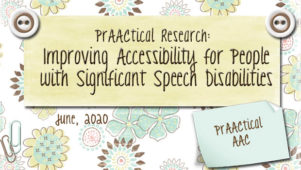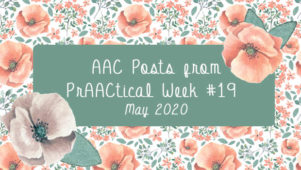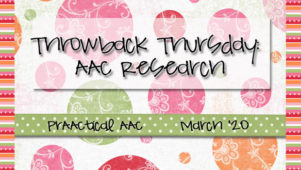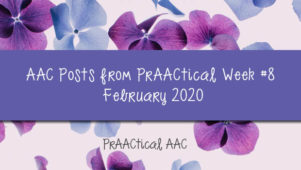PrAACtical Research: Meta-synthesis of AAC Team Members’ Voices
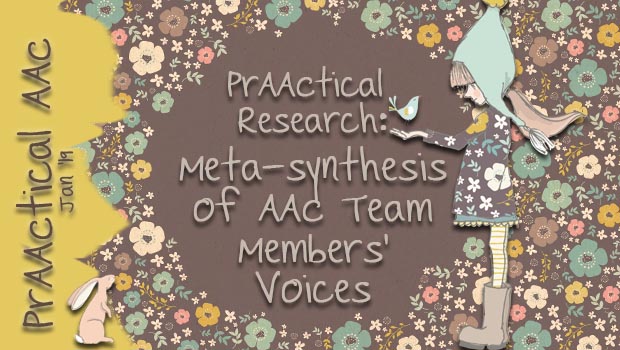
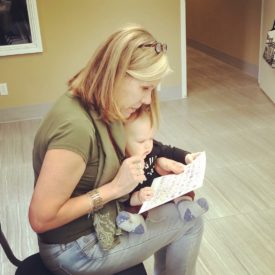 We are delighted to start off the New Year by welcoming back Dr. Kathy Howery for another wonderful review of an AAC research article. Dr. Howery has worked in the field of assistive technology and special education for over three decades. Her research uses phenomenological methods to seek understanding of the lived experience of speaking with/through a speech-generating device. She is currently on contract with the Ministry of Education low incidence team, and as a consultant to schools and school districts across Alberta focusing primarily on children and youth with complex communication needs. In today’s post, she discusses a research study that sheds light on the ways that we can better support students with AAC needs.
We are delighted to start off the New Year by welcoming back Dr. Kathy Howery for another wonderful review of an AAC research article. Dr. Howery has worked in the field of assistive technology and special education for over three decades. Her research uses phenomenological methods to seek understanding of the lived experience of speaking with/through a speech-generating device. She is currently on contract with the Ministry of Education low incidence team, and as a consultant to schools and school districts across Alberta focusing primarily on children and youth with complex communication needs. In today’s post, she discusses a research study that sheds light on the ways that we can better support students with AAC needs.
::::::::::::::::::::::::::::::::::::::::::::::::::::::::::::::::::::::::::::::::::::::::::::::::::::::::::::::::::::::::::::::::
Chung, Y-C. & Stoner, J. B. (2016). A meta-synthesis of team members’ voices: what we need and what we do to support students who use AAC. Augmentative and Alternative Communication, 32 (3), 175-186.
What this article is all about (the focus of the research):
The focus of this article ‘was in obtaining, from published qualitative research, the collective perspectives of AAC team members who worked with students who use AAC in the United States public schools’ (p. 176). The paper presents a meta-synthesis of 10 qualitative studies that gathered and reflected upon perspectives of team members who were supporting students who use AAC. The authors systematically synthesize these qualitative research papers in order to identify and explore the issues and concerns of team members that arose across the studies.
How they gathered their information:
Chung and Stoner searched the literature for studies that:
- used qualitative methods
- reported educational team member perspectives on support primarily school-aged students who use AAC in United States public schools that served both students with and without disabilities (they limited the studies to the United States as in the US schools are required by law (IDEA) to provide services).
- were published in peer-reviewed journals between 1997 and December of 2014.
From the original 655 citations that were found in their original database search, they ended up with 10 studies that met their inclusion criteria and that were NOT case studies, discussion papers, or papers examining attitudes towards students who use AAC.
In their analysis ,both authors independently coded the descriptive information of each article, the study measures, and the main findings of each study. They further looked at the quality of each of the studies using quality indicators proposed by Brantlinger, Jimenez, Klinger, Pugash, and Richardson (2005) which is a commonly used standard in the field of special education. Finally using an open coding system followed by categorization of the emergent codes, three major categories emerged from the data. These were: inputs, activities, and student outcomes.
What the authors learned from their study:
Chung and Stoner found that three major categories emerged from the meta-synthesis: Inputs, Activities, and Outcomes.
Inputs – similar inputs emerged across participant roles that influenced the implementation of activities and reported outcomes.
These included:
- characteristics of team members and AAC – student characteristics, family characteristics, and education professional characteristics and characteristics of the AAC devices
- supports including time, external and /or internal training, and financial resources
Activities – participants across studies described similar activities with an underlying theme of collaboration (p.181).
These activities included:
- team collaboration
- evaluation
- meeting and planning
- instruction
Outcomes – what happened as a result of the inputs and activities.
These included:
- student outcomes
- peer outcomes
- professional outcomes
- family outcomes
While detailed descriptions of each of these inputs, activities, outcomes cannot be presented in this review I have recreated Table 2 from the paper (p. 179) in order to provide a summary of the themes. Additionally, I have noted two important findings from the study as related to family and professionals as inputs to the AAC service provision.
|
Category |
Summary |
| Inputs | |
| Characteristics | |
| Students | Students’ skills and dispositions interacted with other inputs, guided activities, and influenced outcomes. |
| Family* | Family involvement was shaped by families’ expectations, preferences, resources, and cultures. |
| Professional** | Professionals’ attitudes, dispositions, skills, and knowledge were key inputs. |
| Device | The strengths and limitations of AAC systems influenced perspectives toward devices. |
| Supports | |
| Time | Professionals identified time as the most critically needed support. |
| Training | Both internal and external training were needed for team members and communication partners. |
| Finance | Financial support was needed to provide devices, training, and substitutes. |
| Activities | |
| Team Collaboration | |
| Evaluation | Two issues that emerged were lack of professional expertise and lengthy waiting times for an evaluation. |
| Meetings & planning | Regular formal or informal meetings were needed to share expectations and progress, as well as to plan instruction. |
| Instruction | Instruction delivery aligned with curriculum and modifications. |
| Outcomes | |
| Student outcomes | Increases were reported in skill competencies, appropriate behaviors, and communication opportunities. |
| Peer outcomes | Peers developed academic and leadership skills and learned to embrace diversity. |
| Prof. outcomes | Professionals enhanced their knowledge of and skills in AAC and changed their attitude and dispositions. |
| Family outcomes | Families reported increased child communication competence and interaction opportunities in the community. |
* When professional dismissed parental concerns, made decisions without parental input, and did not prepare parents for how to use the device and/or how to integrate it into daily routines, the effect on student outcomes was diminished (p. 180).
** Perhaps the most important professional characteristic was the ability to communicate effectively (p. 180).
A Logic Model for AAC Services!
Finally, in what they call a Holistic View Chung and Stoner draw upon the field of program evaluation to present their findings in terms of a “logic model’. Logic models are arguably the cornerstone of any program evaluation. They have been employed for several decades by program managers and evaluators to describe the effectiveness of their programs (McCawley, 2001). Chung and Stoner argue that the categories that emerged from their study are consistent with a logic model in that they these inputs, activities, and outcomes are necessary for supporting any kind of program and that they can then be used to evaluate said program.
Logic models are typically presented in the form of a diagram. Below is the presentation of the logic model as proposed by Chung & Stoner’s meta-synthesis. One can understand this a flowchart as well and a chart that illustrates what is necessary for positive outcomes in AAC services provision. If inputs are lacking, then activities will not have the needed components which in term will likely have a negative impact on outcomes.
They are also a mechanism for exploring why the intended outcomes may not be seen from the program. That is, to explore what might be the missing inputs or activities that are reducing the likelihood of positive outcomes?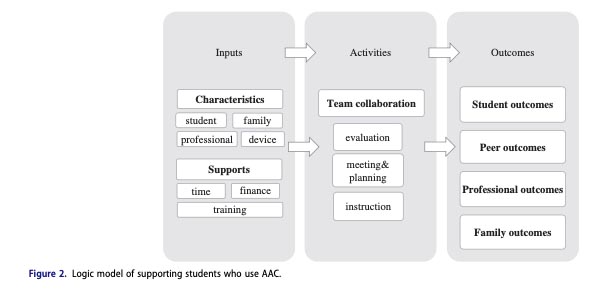
Why is this article important for practice?
While there are scores of articles that warrant a review for PrAACtical AAC in that they provide important information for those of us who are interested in the field of AAC practices when I read this article I felt immediately that it was one that needs to be shared.
I have long been an advocate of evaluation of the supports and services that we put into place for students with complex communication needs, an, in particular, the service provision for those who are using aided forms of AAC. In my doctoral studies I more than a year learning about program evaluation, doing program evaluations and supporting school teams in evaluating their own programs. This was before I came back to what I will say my heart and listening to the stories of young aided communicators talk about their lived experience.
The Chung and Stoner paper, for me, combined three areas that I think make it a very important paper:
- systematically exploring and placing value on qualitative researcher and voices from the field,
- setting a programmatic pathway to the design and evaluation of quality services, and
- finally that this exploration and programmatic pathway is needed in the field of AAC.
As the authors suggest there are (at least) four conclusions that can be drawn from their meta-synthesis, all of which make this a study worth sharing.
- That these categories can offer a holistic view (a model) for policymakers, administrators, advocates, and team members to examine AAC services. Their proposed logic can be used as a guidepost for team members to collect information and determine if the inputs into a system are adequate, to determine if the activities are present and effective, and to determine if desired outcomes are met (p. 184).
- That effective teaming, while important to outcomes, for many educational teams supporting students with complex communication needs remains a work in progress. In the reviewed studies more participants identified barriers to supporting students who used AAC associated with lack of inputs and/or activities. They suggest this may be because administrators do not understand the extensive support needs of students who use AAC. Maybe the findings from this study can help them to understand.
- Even with less than adequate inputs and activities, participants across the studies still reported many positive experiences! This could be that positive team characteristics could mediate some of the gaps in services. They suggest in this instance the Logic Model could be a tool used by teams to advocate for inputs and more effective activities.
- Finally, and this from an AAC professional from Canada is a conclusion near and dear to my heart, that their findings have potential applicability to teams delivering services in countries other than the United States. They suggest, and as a professional with more than a couple decades involved in AAC service delivery I agree, that it is likely that the needs of students and teams are universal. Even without laws similar to IDEA countries could look to the finding of this meta-synthesis to evaluate, improve, and/or even begin AAC Supports.
While there is arguably no secret sauce for effective AAC services, I would argue this article goes a long way towards providing the field with a pretty rich recipe!
:::::::::::::::::::::::::::::::::::::::::::::::::::::::::::::::::::::::::::::::::::::::::::::::::::::::::::::::::::::::::::::::
References
Brantlinger, E., Jimenez, R., Klingner, J., Pugach, M., & Richardson, V. (2005). Qualitative studies in special education. Exceptional Children, 71, 195–207.
McCawley, P.F. (2001).The Logic Model for Program Planning and Evaluation. Available from: https://www.researchgate.net/publication/237568681_The_Logic_Model_for_Program_Planning_and_Evaluation [accessed Jan 02 2019].
You can read other posts by Dr. Howery here.
Filed under: Featured Posts, PrAACtical Thinking
Tagged With: AAC teams, Kathy Howery, meta-analysis, research
This post was written by Carole Zangari

